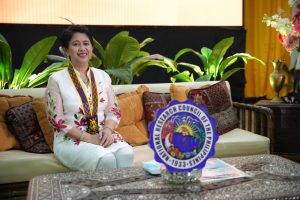“Ecologically speaking, Lake Lanao is still healthy,” declared by Dr. Fema M. Abamo, the Vice Chancellor for Research, Extension, and Development, during the National Research Council of the Philippines (NRCP) Regional Mindanao Policy Forum held last 27 April 2023 at the International Convention Center, Mindanao State University (MSU) Marawi Campus, in a form of a talk show. The event aimed to translate the results of Dr. Abamo’s research in Lake Lanao into policy recommendations, a project funded by NRCP titled Preliminary Inventory and Diversity Of Ciliated Protozoans in Lake Lanao: Its Spatial and Temporal Variations and Its Bioindication on Lake’s Water Quality
The talk show, an episode of NRCP’s “May Magandang Bukas Mula sa Pagtuklas” was hosted by the Executive Director of DOST-NRCP, Dr. Bernardo N. Sepeda, and was attended by representatives of various local government units of Lanao del Sur, BARMM Provincial Environment, and Provincial Environment and Natural Resources Office (PENRO), and faculty members of the university. The discussion was about Dr. Abamo’s research on the water quality of Lake Lanao using ciliated protozoans as bioindicators.
Dr. Abamo’s research team collected water samples from different locations, namely Marawi City, Ramain, Taraka, Balindong, and Binidayan. Two sampling substations were established in these areas: littoral zone (shallow section) and pelagic zone (deeper section) of Lake Lanao. Water samples were collected during mixing, non-mixing, dry, and wet seasons between 2016 to 2018. These water samples were examined to determine the abundance of ciliated protozoans, which are one-celled eukaryotes characterized by the presence of hair-like structures called cilia. Ciliates abundance was used as a bioindicator of organic pollution in Lake Lanao. The research intended to assess the trophic state of the lake based on planktonic ciliate abundance. Overall, the ciliate abundance was below 2.4 cells/mL in all the sampling periods and in all sampling areas, suggesting that the trophic state of Lake Lanao falls under ultraoligotrophic. This means that Lake Lanao is characterized by low accumulation of dissolved nutrient salts, supporting a sparse growth of algae, and having a high oxygen content owing to the low organic content. In other words, Lake Lanao is ecologically healthy.
“As any body of water, Lake Lanao is also confronted with environmental pressures, maybe due to the increasing number of human populations thriving around Lake Lanao and also climate change,” Dr. Abamo declared in her talk. Not unknown to locals, Lake Lanao is extremely pivotal in shaping the identity of the Meranao people. The lake serves multiple purposes, including the source of livelihood, drinking water, domestic activities, and irrigation. However, the increasing number of settlements near the lake is threatening its overall state.
Dr. Glen Lorenzo, vice president for Research and Development, has also emphasized the importance of collaboration with DOST-NRCP for research and development. “Atty. Basari D. Mapupuno, the MSU system President, put premium on research and extension. In fact, his top two agenda talk about academic excellence and research excellence. To attain this goal, one of the strategies is to establish research centers which include Lake Lanao and Watershed Research Center.” The importance of conducting research on Lake Lanao and its watershed has been given more emphasis when Dr. Lorenzo declared, “Lake Lanao is life to the people in Lanao and to the rest of the people in Mindanao. About 70% of the electric needs of Mindanao comes from the hydroelectric plants, which are being supplied by the water coming from Lake Lanao.”
While Lake Lanao remains ecologically healthy, Dr. Abamo’s important message was the challenge to maintain its healthy state and implement effective measures to protect the lake from various threats and to conserve its environs. The representatives of the municipal government units and other relevant stakeholders have expressed their commitment of support to protect the lake from human and non-human threats. Forester Pili M. Papandayan, the PENRO-Lanao del Sur, recognized the importance of the study to the targets of the province to have research on environment and natural resources and energy profiling and preservation of the endemic fish. Forester Asmarie M. Labao, PENREO-Lanao del Sur, said “the different stakeholders are here to continue our efforts to protect Lake Lanao and its surroundings.” The municipal mayor of Wato-Balindong, Hon. Amer-Reggie L. Bagul, has also expressed his support for research, particularly about the native fish species in Lake Lanao to help improve the aquaculture industry in his municipality. Representing the education sector, Prof. Mariam A. Sunggod was happy with the results, and she added “We in the education sector, our responsibility here is how can we communicate that result to the younger generation…how can we educate our young learners to help in taking care Lake Lanao, to be stewards.”
The event ended by calling on stage some members of the research team of Dr. Abamo, to wit, Prof. Camar P. Ameril, Prof. Cyrollah R. Disoma, and Ms. Hamema D. Cosain.#






